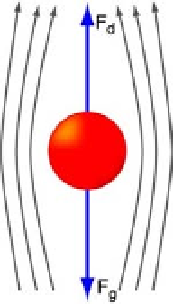Biomedical Engineering Reference
In-Depth Information
FIGURE 14.30
Slow flow past a falling sphere, which forms the basis of a falling sphere viscometer.
The fluid is placed between two cylinders with large radii and with a gap width between
the cylinders that is very small compared to the radii. One of the cylinders rotates while
the other remains stationary. With a small gap width, the velocity between the cylinders
approaches a linear profile. The torque required to spin the cylinder as a function of the cyl-
inder rotation rate provides the fluid viscosity. Different fluids would have different linear
flow profiles between the cylinders, indicating different values of viscosities. A typical con-
centric cylinder viscometer is shown in Figure 14.31.
14.2.2 Conservation of Mass
The equation that describes fluid flow as a function of the pressure gradient in a tube is
used to describe blood flow in a blood vessel or air flow in the trachea and bronchioles. As
was the case with diffusion occurring in the direction of decreasing concentration gradient,
so is the case of fluid flow in the direction of decreasing pressure in a blood vessel. In the
human systemic circulation, the aortic pressure is 120 systolic pressure over 80 diastolic
pressure (in mm Hg). This is because blood flow is pulsatile when it comes from the aortic
valve as the ventricles undergo systolic contraction followed by diastolic relaxation. The blood
pressure is 100 mm Hg mean and eventually decreases to about 5-10 mm Hg at the vena
cava. Thus, there is a 90-95 mm Hg pressure gradient that pushes blood around the systemic
circulation. Blood flow in the aorta is highly accelerated and time varying and continues
around the sharp bend of the aortic arch. The equations that describe blood flow and fluid
mechanics are time varying in nature, as well as affected by spatial variation due to the
changing geometry/anatomy of the circulatory system. These equations include the equa-
tion relating to the conservation of mass (sometimes called the continuity equation) and the
equations of fluid momentum (sometimes called the equations of fluid motion).
As was just noted, the type of fluid (Newtonian or non-Newtonian) can affect the equations
related to fluid mass and fluid momentum. For simplicity, we can assume that blood acts New-
tonian and can then alter that assumption after deriving the preceding equations. The continu-
ity equation for a Newtonian fluid is shown in the following equation. We are using the version
of this equation in cylindrical coordinates because blood vessels are cylinders. Thus, the veloci-
ties associated with this coordinate system are in the z direction (axially downstream),


